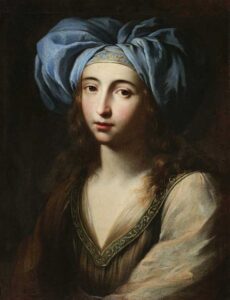
Elisabetta Sirani: Cleopatra
Loretta Pettinato
(Translated by Laura Pettinato)

An exhibition called ‘Women of Art. Stories of women from the 1500s to the 1600s’ was due to open on March 2nd 2021 in the Palazzo Reale in Milan, but its inauguration was delayed following the latest lockdown. The end of this exhibition has not been changed and it remains July 25th 2021. In-person visits have nevertheless been replaced by virtual ones, meaning that it is still possible to delve into this varied and catalogued exhibition, comprising 130 paintings. These canvases come both from Italian collections and foreign ones and were painted by 35 talented women who courageously and tenaciously took a stand against a world which was almost exclusively controlled by men, becoming the women of Baroque. These were either the painters’ daughters, wives and sisters who learned the basics of the craft just by watching the male artists in their workshop, as they were precluded from any kind of artistic education, or women who had been secluded in convents, working in the service of the religious community. Almost every painting represents stories of different women, such as Judith, Penitent Magdalene, Eleonora Gonzaga, Galthea riding a sea monster, and two girls portrayed playing chess.
Some paintings were created by lesser-known artists; these include the Roman noblewoman Claudia del Bufalo’s Portrait of Faustina del Bufalo, Rosalia Novelli’s Immaculate Virgin, and Lucrezia Quistelli’s Saint Catherine’s Mystic Wedding. Others were famous at the time but later forgotten, like Lavinia Fontana from Bologna who was the family’s breadwinner thanks to her art, or Giovanna Garzoni, painter of the only two male portraits in the exhibition: Emanuele I Duke of Savoia, and Emanuele Filiberto.
Mostly the artwork is exhibited without deep critical analysis, the analysis being inherently the fact that these women are not better known and more widely accepted for their skill even today when women have been ‘liberated’ from formal restrictive, positions in masculine defined societies.

One can also find paintings whose artists gained international recognition: Fede Galizia for instance, known for her Still Life paintings, and several by Artemisia Gentileschi, probably the most famous artist in the show, including David with Goliath’s Head. Gentileschi is an emblem of courage and determination, overcoming the trauma of a sexual assault and opposing her father’s dominion to become a wealthy entrepreneur in her own right. Altarpiece of Itria’s Madonna and Chess Game are the work of another independent woman, Sofonisba Anguissola from Cremona, who, after living for 10 years in Philip II’s court in Madrid, moved back to Sicily and married a younger man. Elisabetta Sirani’s work, including Porzia Wounding her Thigh, and Cleopatra, depicts sensuality, courage and rebellion against the violence of men toward women.
The exhibition is organized into five sections. The first is dedicated to the artists Vasari wrote a biography about; the second to those who painted in convents; the third to paintings representing families, such as Marietta Robusti’s (the daughter of Tintoretto); the fourth section celebrates academies, and the fifth is dedicated to Gentileschi. Apart from a few pieces, this isn’t an exhibition of masterpieces, but a journey across art history and Renaissance society. The main goal is to reveal the lives of many women artists who were unfairly forgotten. These women were the light in this bigoted and misogynist society, they suffered and fought in order to gain their freedom and independence and were able to devote themselves entirely to art.
Volume 35 no 5 May / June 2021

